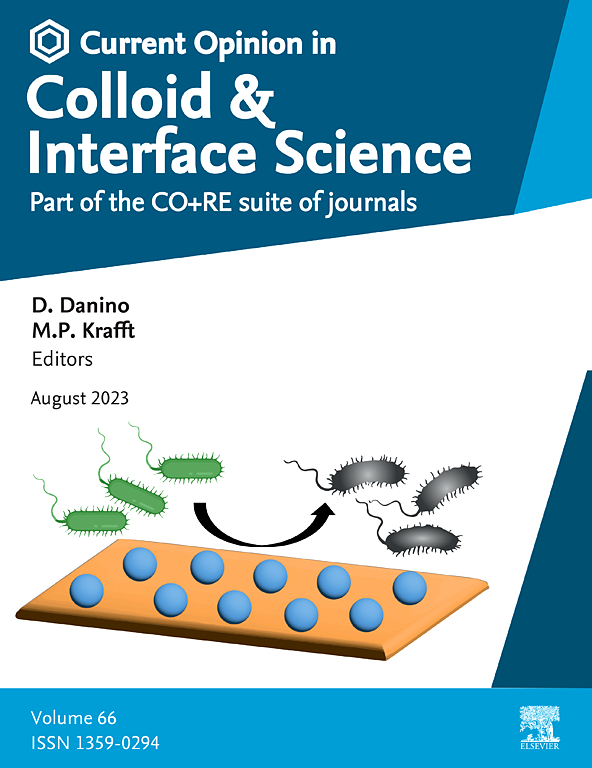A review of recent trends in structuring oleogel-based emulsions for food applications
IF 7
2区 化学
Q1 CHEMISTRY, PHYSICAL
Current Opinion in Colloid & Interface Science
Pub Date : 2025-05-14
DOI:10.1016/j.cocis.2025.101924
引用次数: 0
Abstract
Oleogel emulsions, a hybrid system combining oleogelation and emulsification, have emerged as a groundbreaking innovation in colloidal science, providing sustainable and healthier alternatives for food formulation. In the broadest sense, oleogel emulsions can be structured by dispersing oleogels in water or vice versa, stabilized by interfacially adsorbed food-grade particles or entangled network structures that retard droplet–droplet coalescence and phase separation. This review aims to provide an up-to-date overview of various oil-structuring approaches, highlighting their properties, different types of oleogel-structured emulsions, and the stabilization mechanisms involved in the formation of oleogel emulsions. Specifically, the factors affecting the characteristics of oleogel emulsions are summarized, including oil types, oil/water ratios, oleogelators, emulsifiers, and processing parameters. Additionally, recent studies on the application of oleogel emulsions in food products are discussed. Currently, there are three main mechanisms responsible for stabilizing oleogel emulsions: Pickering particles, network stabilization, or a combination of both. The droplet size, physical stability, and rheological properties of oleogel emulsions are strongly influenced by the nature and concentration of the oleogelators used as they gel the oil phase, which helps achieve the desired thermomechanical and microstructural properties. Similarly, changes in the type of oils or oil/water ratios used directly impact the physicochemical properties of the systems. These structured emulsions have been widely used as fat substitutes in various food products such as ice cream, cakes, spreads, sausages, margarine, burgers, and peanut butters.

综述了食品用油凝胶基乳剂结构的最新趋势
油凝胶乳液是一种结合了油凝胶和乳化的混合体系,已经成为胶体科学的突破性创新,为食品配方提供了可持续和更健康的替代品。从最广泛的意义上讲,油凝胶乳液可以通过将油凝胶分散在水中来构建,反之亦然,通过界面吸附的食品级颗粒或纠缠的网络结构来稳定,这些结构可以延缓液滴之间的聚结和相分离。本综述旨在提供各种油结构方法的最新概况,重点介绍了它们的性质,不同类型的油凝胶结构乳剂,以及形成油凝胶乳剂的稳定机制。具体而言,总结了影响油凝胶乳液特性的因素,包括油类型、油水比、油凝胶剂、乳化剂和工艺参数。此外,还讨论了近年来油凝胶乳剂在食品中的应用研究。目前,有三种主要机制负责稳定油凝胶乳液:Pickering颗粒,网络稳定,或两者的组合。油凝胶乳液的液滴大小、物理稳定性和流变性能在很大程度上受到油凝胶剂的性质和浓度的影响,这有助于实现所需的热机械和微观结构性能。同样,油的类型或油水比的变化也会直接影响体系的物理化学性质。这些结构乳剂已被广泛用作各种食品中的脂肪替代品,如冰淇淋、蛋糕、酱料、香肠、人造黄油、汉堡和花生酱。
本文章由计算机程序翻译,如有差异,请以英文原文为准。
求助全文
约1分钟内获得全文
求助全文
来源期刊
CiteScore
16.50
自引率
1.10%
发文量
74
审稿时长
11.3 weeks
期刊介绍:
Current Opinion in Colloid and Interface Science (COCIS) is an international journal that focuses on the molecular and nanoscopic aspects of colloidal systems and interfaces in various scientific and technological fields. These include materials science, biologically-relevant systems, energy and environmental technologies, and industrial applications.
Unlike primary journals, COCIS primarily serves as a guide for researchers, helping them navigate through the vast landscape of recently published literature. It critically analyzes the state of the art, identifies bottlenecks and unsolved issues, and proposes future developments.
Moreover, COCIS emphasizes certain areas and papers that are considered particularly interesting and significant by the Editors and Section Editors. Its goal is to provide valuable insights and updates to the research community in these specialized areas.

 求助内容:
求助内容: 应助结果提醒方式:
应助结果提醒方式:


